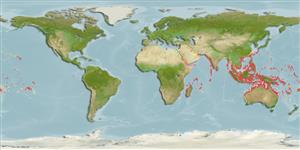>
Eupercaria/misc (Various families in series Eupercaria) >
Labridae (Wrasses) > Corinae
Etymology: Hemigymnus: Greek, hemi = half + Greek, gymnos = naked (Ref. 45335).
More on author: Bloch.
Environment: milieu / climate zone / depth range / distribution range
ນິເວດວິທະຍາ
ສັດທະເລ ກ່ຽວກັນຫີນ; ລະດັບຄວາມເລິກ 0 - 30 m (Ref. 9710), usually 5 - 30 m (Ref. 27115). Tropical; 24°C - 28°C (Ref. 27115); 30°N - 36°S, 24°E - 138°W
Indo-West Pacific: Rde Sea, East Africa to Samoa; north to Ryukyu Is.; south to Australia.
ຂະໜາດ / ນ້ຳໜັກ / Age
Maturity: Lm ? range ? - ? cm
Max length : 39.6 cm TL ຕົວຜູ້/ບໍ່ມີເພດ; (Ref. 125598); ນ້ຳໜັກສູງສຸດທີ່ເຄຍຈັດພີມມາ: 1.3 kg (Ref. 125598)
ຄີ (ໜາມ)ແຂງຢູ່ຫຼັງປາ (ທັງໝົດ): 9; ຄີຫຼັງຂອງປາ (ຄີອ່ອນ) (ທັງໝົດ): 10-11; ຄີ(ໜາມ) ແຂງຢູ່ຄີກົ້ນປາ
ກຸ່ມປາກະດູກແຂງ
ຄວາມຖີ່ຂອງກຸ່ມຖ່າຍທອດພັນ
ປາທີ່ມີການເຄື່ອນຍ້າຍຈາກທະເລໄປຫານ້ຳຈືດ ແລະນ້ຳຈືດຫາທະເລ
ປາທີ່ມີການເຄື່ອນຍ້າຍຈາກທະເລແລະໄປໄຂ່ຢູ່ນ້ຳຈືດ
ຄີກົ້ນຂອງປາ
ສັດທີ່ມີກະດູກສັນຫັຼງ
ການຖ່າຍທອດທາງກຳມະພັນຈາກພໍ່ແມ່ຫາລູກ 3; ຄີກົ້ນຂອງປາ: 11. This species is distinguished by the following characters: gill rakers 26-29; small juveniles dark brown, green on snout and interorbital, with a slightly oblique white bar from front of dorsal fin to abdomen, and 2 narrow pale yellowish bars below soft portion of dorsal fin that fade ventrally; larger juveniles have a white bar from origin of dorsal fin, passing beneath pectoral fin onto abdomen; head and body anterior to bar greyish green, posterior to bar black; posterior caudal peduncle and caudal fin yellow, often with 1 or 2 small black spots centrally near base: small females with body posterior to a curving demarcation between origins of dorsal and anal fins blackish with a narrow dark greenish bar on each scale, grading to yellow with blue-green spots posteriorly on caudal peduncle and fin; large females dark green posterior to oblique demarcation on body, the scales rimmed in black, with a vertical green line or spot on each scale; head and anterior body light green dorsally, pale blue-green ventrally, have irregular bands on snout and above eye, and a large complex marking behind eye; body of males posterior to demarcation dark green, each scale with narrow pale blue-green and black posterior margin; head green dorsally with irregular green to blue-green bands, including a blue ring around eye; cheek and operculum pinkish white with irregular light blue lines and spots, except for a large yellowish green blotch centrally on cheek without markings; lips and ventral part of head mainly pale blue; chest and abdomen pinkish white with a light blue spot or arc on scales (Ref. 93095).
Found in subtidal reef flats and lagoon and seaward reefs. Juveniles occur inshore, found among branching corals while adults found in areas of mixed sand, rubble, and coral (Ref. 9710). Large adults in deeper water (Ref. 48636). Maximum length beyond 45 cm TL is unlikely, with largest measured individual at 37 cm TL (Ref, Feeds mainly on small invertebrates, especially crustaceans, polychaete worms, mollusks and brittle stars (Ref. 9823). Diet changing from primarily demersal planktonic crustaceans to hard-shelled invertebrates with growth (Ref. 37816). Minimum depth reported taken from Ref. 128797.
Life cycle and mating behavior
ການຈະເລີນເຕັມໄວ | ການສືບພັນ | ການວາງໄຂ່ | ໄຂ່ | ຄວາມດົກຂອງໄຂ່ປາ | ຕົວອ່ອນ
Oviparous, with distinct pairing during breeding (Ref. 205).
Randall, J.E., 2013. Review of the Indo-Pacific labrid fish genus Hemigymnus. J. Ocean Sci. Found. 6:2-18. (Ref. 93095)
IUCN Red List Status (Ref. 130435)
Threat to humans
Harmless
Human uses
ການປະມົງ: ທີ່ເປັນການຄ້າໜ້ອຍ; ຊະນິດປາທີ່ຖືກນຳໃຊ້ເຂົ້າໃນການຫາເພື່ອເປັນເກມກິລາ: ແມ່ນ; ຕູ້ປາ: ເປັນສີນຄ້າ
ຂໍ້ມູນຕື່ມອີກ
ຊື່ສາມັນຄຳສັບຄ້າຍຄືກັນການເຜົາໃໝ້ພະລັງງານໂດຍປ່ຽນທາດອາຫານໃນຮ່າງກາຍໃຫ້ກາຍເປັນຊີ້ນແລະໜັງຜູ້ລ້າການສຶກສາຜົນກະທົບຂອງສານຜິດທີ່ມີຜົນກະທົບຕໍ່ລະບົບນິເວດການສືບພັນການຈະເລີນເຕັມໄວການວາງໄຂ່ການສັງລວມການວາງໄຂ່ຄວາມດົກຂອງໄຂ່ປາໄຂ່Egg development
ເອກະສານອ້າງອີງການລ້ຽງສັດນ້ຳຂໍ້ມູນການລ້ຽງສັດນ້ຳສາຍພັນກຳມະພັນElectrophoresesການຖ່າຍທອດທາງກຳມະພັນຈາກພໍ່ແມ່ຫາລູກພະຍາດການປຸງແຕ່ງNutrientsMass conversion
ເຄື່ອງມື
Special reports
Download XML
ແຫຼ່ງອີນເຕີເນັດ
Estimates based on models
Preferred temperature (Ref.
123201): 24.6 - 29, mean 27.8 °C (based on 1006 cells).
Phylogenetic diversity index (Ref.
82804): PD
50 = 0.6250 [Uniqueness, from 0.5 = low to 2.0 = high].
Bayesian length-weight: a=0.01318 (0.00824 - 0.02108), b=3.06 (2.92 - 3.20), in cm total length, based on LWR estimates for this species & (Sub)family-body (Ref.
93245).
ຊັ້ນເຂດຮ້ອນ (Ref.
69278): 3.6 ±0.45 se; based on food items.
ຄວາມຢືດຢຸ່ນ (Ref.
120179): ຂະໜາດກາງ, ປະຊາກອນຕຳ່ສຸດທີ່ໃຊ້ເວລາສອງເທົ່າ 1.4 - 4.4 ປີ (Preliminary K or Fecundity.).
Fishing Vulnerability (Ref.
59153): Low to moderate vulnerability (30 of 100).
Nutrients (Ref.
124155): Calcium = 28.8 [15.3, 87.8] mg/100g; Iron = 0.544 [0.320, 0.977] mg/100g; Protein = 18.6 [15.7, 20.8] %; Omega3 = 0.154 [0.078, 0.309] g/100g; Selenium = 31.1 [11.2, 81.1] μg/100g; VitaminA = 115 [36, 396] μg/100g; Zinc = 2.73 [0.87, 4.69] mg/100g (wet weight);
